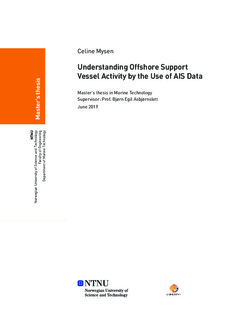| dc.description.abstract | Denne oppgaven undersøker om Automatisk indentifikasjonssystem (AIS) data kombinert med markedsdata fra offshore olje- og gassindustrien kan gi innsikt i operasjoner utført av forsyningsfartøy. All offshore olje- og gassaktivitet blir støttet opp av et komplekst logistikkmønster og et stort antall forsyningsbaser som utgjør en viktig rolle for kystsamfunnene. Det finnes lite kvantitative data på fartøyenes operasjoner, noe som gjør det vanskelig å analysere sektorens betydning. Motivasjonen for denne masteroppgaven er å bidra til å fylle dette informasjonsgapet, og forhåpentligvis bidra med verdifull innsikt i en industri som er viktig for den norske økonomien.
En grundig litteraturgjennomgang presenteres for å undersøke state-of-the-art innen emnene og for å identifisere eventuelle utfordringer. Datagrunnlaget for denne oppgaven er delvis gitt fra Rystad Energy og delvis hentet fra Oljedirektoratet sine offentlige kilder. Et dypdykk inn i industrien knyttet til forsyningsfartøyene og egenskapene til AIS-data er gjennomført med mål om å tilegne seg kunnskap om hvordan posisjonsdataene kan brukes til å beskrive operasjonene til forsyningsfartøyene. Resultatet er et metodologisk rammeverk egnet for å identifisere fartøyenes operasjonsmønster. Stegene for å bygge opp en slik modell er forklart i detalj gjennom denne masteroppgaven.
Modellen identifiserer fartøysoperasjoner ved å vurdere fartøyenes avstand til nærmeste kyst og annen nærliggende infrastruktur, i all hovedsak produksjonsplattformer og borerigger. Modellen er evaluert gjennom en casestudie hvor aktiviteten til forsyningsfartøy på den norske kontinentalsokkelen fra midten av 2013 og til og med desember 2018 blir analysert. Aktivitetsnivåene blir analysert basert på tiden som er brukt og antall turer som har gått med på å forsyne offshore installasjonene. Jevnt over viser modellen lovende resultater. Casestudiet viser at modellen klarer å fange opp flere av de velkjente trendene og forventningene hva gjelder forsyningsfartøyaktivitet. Dette gjelder blant annet sesongvariasjoner, forbindelsen mellom rig-aktivitet og turer seilt av ankerhåndteringsfartøy, og evnen til å knytte fartøysaktivitet til hvert enkelt felt på sokkelen. Dog illustrerte resultatene også vanskelighetsgraden knyttet til å beskrive det komplekse operasjonsmønsteret. Det ble funnet spesielt vanskelig å skille hendelser hvor skipet faktisk utførte et arbeid med hendelser hvor skipet ventet på å få utføre et arbeid. I tillegg ble det observert at forsyningsfartøyenes operasjoner ikke fullt kan bli beskrevet kun med infrastrukturdataen som er inkludert i denne oppgaven.
Det er konkludert med at AIS-data kan bidra til å gi verdifull innsikt i operasjoner knyttet til forsyningsfartøy. Den delen av metodikken som kombinerer AIS-data sammen med annen markedsdata er funnet til å være en suksess. Siden ingen data på faktiske fartøysoperasjoner har vært tilgjengelige har modellen blitt evaluert basert på generell forståelse av industrien og markedet, årsrapporter og diverse nyhetsartikler. Denne oppgaven anbefaler videre arbeid innenfor feltet og foreslår arbeid knyttet til å forbedre modellparameterne, anskaffe bedre AIS-data eller ta i bruk mer komplekse metoder for å fylle data hull og utvidelse av modellen til å inkludere all type offshore infrastruktur. | |
| dc.description.abstract | This thesis investigates whether coupling Automatic Identification System (AIS) data from offshore support vessels (OSV) with market data from the offshore oil and gas industry can provide insight into OSV operations. All offshore oil and gas activities are supported by complex logistical patterns and a large number of supply bases making out an industry playing a huge role for the coastal communities. Still, little quantitative data is available on the spatial and temporal distribution of the support vessel activities, and therefore the impacts of these activities cannot be analysed. The motivation for this master thesis is to contribute in the filling of this \textit{information gap} and potentially provide valuable insight into an important industry for the Norwegian economy.
A thorough literature review investigating the state-of-the-art within the topic and identifying potential challenges is conducted. The data used in this research consist of data provided by Rystad Energy and data gathered from the Norwegian Petroleum Directorate's public sources. A deep-dive into both the operations of OSVs and the properties of AIS data is conducted with the aim to understand how vessel activity can be described by the use of positioning data. The result is a methodological framework applicable for identifying the spatial and temporal distribution of OSV operations. The steps building up the model is described in detail through this thesis.
The model identifies vessel operations by evaluating the vessels' distance from shore and nearby infrastructures, mainly production platforms and drilling rigs. The model is evaluated through a case study where the activities on the Norwegian continental shelf (NCS) from mid-2013 to end-2018 are analysed. The activity levels are analysed in terms of time spent on voyages and the number of voyages servicing the offshore infrastructures. Overall, the case study showed promising results as the model was able to capture some of the well-known trends and expectations regarding OSV operations. Some of the results were the model's capability to capture the seasonal variations, the dependency between rig and anchor handling tug supply (AHTS) vessel activity and assigning vessel days to each of the fields on the NCS. However, the results also shed light on the complexity of the logistical patterns. Especially, it was found hard to distinguish active work from offshore waiting. It was also found that the fleet's activities cannot fully be described solely based on the offshore infrastructures included in this study.
In conclusion, the case study provides evidence in favour of using AIS data to understand OSV activities. The key part of the model, combining AIS data with infrastructure data, was found to be a success for analysing OSV activity on a region, operator and field level. As no operational data has been available the model has been evaluated based on industry insight obtained during the process of developing the model, annual reports and news articles. This thesis suggests further work in refining the model parameters, improve the quality of the input data and extend the model to cover all types of offshore infrastructures, as well as further model testing and evaluation. | |
